I have a matrix which consists of positive and negative values. I need to do these things.
Let u(i,j) denote the pixels of the matrix u.
- Calculate the zero crossing pixels. These are the pixels in the grid if
u(i-1,j)andu(i+1,j)are of opposite signs oru(i,j-1)andu(i,j+1)are of opposite signs. - Then I need to calculate the narrow band around these zero crossing pixels. The width of the narrow band is
(2r+1)X(2r+1)for each pixel. I am takingr=1so for it I have to actually get the 8 neighborhood pixels of each zero crossing pixels.
I have done this in a program. Please see it below.
%// calculate the zero crossing pixels
front = isfront(u);
%// calculate the narrow band of around the zero crossing pixels
band = isband(u,front,1);
I am also attaching the isfront and isband functions.
function front = isfront( phi )
%// grab the size of phi
[n, m] = size(phi);
%// create an boolean matrix whose value at each pixel is 0 or 1
%// depending on whether that pixel is a front point or not
front = zeros( size(phi) );
%// A piecewise(Segmentation) linear approximation to the front is contructed by
%// checking each pixels neighbour. Do not check pixels on border.
for i = 2 : n - 1;
for j = 2 : m - 1;
if (phi(i-1,j)*phi(i+1,j)<0) || (phi(i,j-1)*phi(i,j+1)<0)
front(i,j) = 100;
else
front(i,j) = 0;
end
end
end
function band = isband(phi, front, width)
%// grab size of phi
[m, n] = size(phi);
%// width=r=1;
width = 1;
[x,y] = find(front==100);
%// create an boolean matrix whose value at each pixel is 0 or 1
%// depending on whether that pixel is a band point or not
band = zeros(m, n);
%// for each pixel in phi
for ii = 1:m
for jj = 1:n
for k = 1:size(x,1)
if (ii==x(k)) && (jj==y(k))
band(ii-1,jj-1) = 100; band(ii-1,jj) = 100; band(ii-1,jj+1) = 100;
band(ii ,jj-1) = 100; band(ii ,jj) = 100; band(ii,jj+1) = 100;
band(ii+1,jj-1) = 100; band(ii+1,jj) = 100; band(ii+1,jj+1) = 100;
end
end
end
end
The outputs are given below:, as well as the computation time:

%// Computation time
%// for isfront function
Elapsed time is 0.003413 seconds.
%// for isband function
Elapsed time is 0.026188 seconds.
When I run the code I do get the correct answers but the computation for the tasks is too much to my liking. Is there a better way to do it ? Especially the isband function? How can I optimize my code further ?
Thanks in advance.